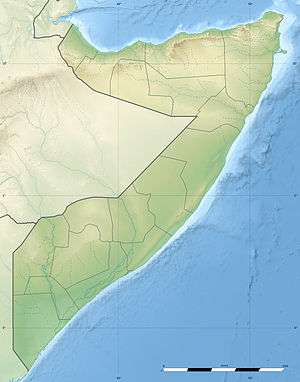Merca
Merca (Somali: Marka, Arabic: مركة) is an ancient port city in the southern Lower Shebelle province of Somalia. It is located approximately 109 km (68 mi) to the southwest of the nation's capital Mogadishu. Merca is the traditional home territory of the 12 Koofi and Bimal clan and was the center of the Bimal Revolt or Merka Revolt.[2]
Merca Marka مَركة | |
|---|---|
City | |
 Merca beachside | |
 Merca Location in Somalia | |
| Coordinates: 01°41′00″N 044°45′00″E | |
| Country | |
| Region | Lower Shebelle |
| District | Merca |
| Population (2019)[1] | |
| • Total | 230,100 |
| Time zone | UTC+3 (EAT) |
History


Merca was established in the 7th century by the Bimaal clan. The first Somalis arrived in the city in the 6th century and gained control of the city and trade of the region.[3]
The 14th-century Arab geographer Ibn Sa'id described Merca as a capital in the Hawiye country but not it being a town belonging to the Hawiye tribe. During the 12th century, the cartographer Muhammad al-Idrisi included Merca as a coastal city left from the country of Hadiye, which Herbert S. Lewis believes is a scribal error for "Hawiye", as do Guilliani, Schleicher and Cerulli.[4]
Geledi Sultanate offense at capturing Merca from the Bimal.
One of the most powerful sultanates to have merged from Southern Somalia around Afgoye in the late 18th (1750) century tried to attack and destroy the Bimal clan many times to try and capture the coastal city of Merca. But the Bimal of Merca managed to defeat the Geledi Sultanate 2 times. In 1843 Yusuf Mahamud, Sultan of Geledi, vows to destroy the Bimal for once and for all and mobilizes the Geledi confederacy containing over 16 clans. In 1848 the sultan of the Geledi, Yusuf Mahamud was is killed at Adaddey Suleyman, a village near Marka, in a battle between the Bimal and Geledi Sultanate. His son Ahmed Yusuf tried to seej revenge but was also killed in 1878 at Agaaran, near Marka by the Bimaal. This caused a steady decline to the Geledi Sultanate. [5]
Bimal or Merca revolt
The Bimal revolt, Bimal resistance, Merca revolt or Banadir resistance was a guerrilla war against the Italian Somaliland in southern Somalia. It was fought from the years 1896 to 1926 and largely concentrated in the Lower Shebelle, Banadir and Middle Shebelle. The war was centered around Merka and Danane.
It is compared to the war of the Mad Mullah in northern Somalia.[6][7] Named after the Bimal clan since they were the major element in the resistance.[8]
For more about Bimal or Merca revolt see:
In the 1930s a group of Italian Somalis established residency in Merca. The Port of Merca was the second in Italian Somalia and was nicknamed the "port of bananas" due to its status as a key exporter of bananas from Somalia to Europe.[9] In the city of Merca there was a huge economical development in the 1930s, due mainly to the growing commerce of the port of Merca connected by small railway to the farm area of Genale.[10]
Merca was abandoned by government forces and captured by Al-Shabaab in February 2016.[11] It was recaptured by the Somali National Army along with African Union troops, a few days later. A small battle was fought in which a Somali soldier, several militants, and four civilians died.[12]
Demographics
According to the UNDP in 2005 Merca had a population of around 63,900 inhabitants.[13] it is primarily inhabited by Somalis from the Bimaal sub-clan of Dir.[14]
Transportation
link=|thumb Merca has a jetty-class seaport, the Port of Merca.[15]
The nearest airport to the city is the K50 Airport in the Lower Shebelle province.
Notable people
Asha Jama, social activist, and former TV reporter and journalist.
Sheikh Abibakar Gafle, described as one of the best known resistance leaders in Southern Somalia and from Merca.[16]
See also
References
- "Population of Cities in Somalia (2019)". Worldpopulationreview.com. Retrieved 2019-07-18.
- http://www.landinfo.no/asset/2736/1/2736_1.pdf Marka is the traditional home territory of the Dir clan Biimaal (Lewis 2008, p. 5).
- Kariye, Badal W. (2016-11-27). The Kaleidoscopic Lover: The Civil War in the Horn of Africa & My Itinerary for a Peaceful Lover. AuthorHouse. ISBN 9781452004631.
- Herbert S. Lewis, "The Origins of the Galla and Somali", in The Journal of African History. Cambridge University Press, 1966, pp 27–30 (not scholarly peer reviewed).
- Mukhtar, Mohamed Haji (2003-02-25). Historical Dictionary of Somalia. Scarecrow Press. ISBN 978-0-8108-6604-1.
- Ciisa-Salwe, Cabdisalaam M. (1996-01-01). The collapse of the Somali state: the impact of the colonial legacy. HAAN. p. 19. ISBN 9781874209270.
- Kusow, Abdi (2004-01-01). Putting the cart before the horse: contested nationalism and the crisis of the nation-state in Somalia. Red Sea Press. p. 82. ISBN 9781569022023.
- Kusow, Abdi (2004-01-01). Putting the cart before the horse: contested nationalism and the crisis of the nation-state in Somalia. Red Sea Press. p. 86. ISBN 9781569022023.
the Bimal clan was the major element in the resistance. See: Gherardo Pantano, Nel Benadir: La Citta di Merca e la Regione Bimal,
- "La colonizzazione agricola nella Somalia italiana 1920/39". March 30, 2015.
- "Map of Genale (green area was the farm concessions) and Merca in the 1930s".
- "Al-Shabaab militants retake Somali port". February 5, 2016 – via www.theguardian.com.
- "Somali troops 'retake' key port city of Merca from al-Shabab - BBC News". BBC News. Retrieved 2016-02-06.
- "Population data" (PDF). docs.unocha.org. Retrieved 2019-07-18.
- Landinfo Somalia: Lower Shabelle. Landinfo Somalia: Lower Shabelle
- "Istanbul conference on Somalia 21 – 23 May 2010 - Draft discussion paper for Round Table "Transport infrastructure"" (PDF). Government of Somalia. Retrieved 31 August 2013.
- Marchal, Roland (1997). Studies on Governance. United Nations Development Office for Somalia.